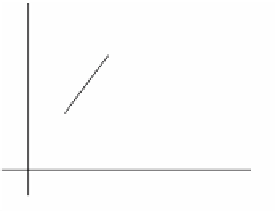Graphics Reference
In-Depth Information
to be the coefficients in the sense that we would be specifying a collection of elements
of L(
R
n
), one for each point of
R
n
. The element that we get at any point in
R
n
is the
one where we replace the function coefficient with the real number that is the value
of the function at that point. This would be an adequate approach if one was only
interested in defining differential forms for
R
n
, but because we have the generaliza-
tion to manifolds in mind (Section 8.12) we shall take a different approach. Rather
than having global functions induce “local” elements of L(
R
n
), we shall build up a
global structure from local ones.
For
p
Œ
R
n
define
(
)
=
(
{
}
n
)
n
T
p
Rp v
,
v
Œ
R
.
(4.26)
We endow the set T
p
(
R
n
) with the natural vector space structure defined by
(
)
+¢
(
)
=
(
)
n
pv
,
pv
,
pv v
,
+
¢
,
vv
,
¢Œ
R
,
and
(
)
=
(
)
n
c
pv
,
p v
,
c
,
c
ŒŒ
R v R
,
.
Definition.
The vector space T
p
(
R
n
) is called the
tangent space
to
R
n
at the point
p
.
The vector (
p
,
v
) in T
p
(
R
n
), often denoted by
v
p
, is called a
tangent vector
to
R
n
at
p
.
The space T
p
(
R
n
) is simply a way of formalizing the notion of each point of
R
n
having its
own
copy of
R
n
thought of as the tangent vectors at that point. One can
think of the vector
v
p
as a vector “starting” at
p
. See Figure 4.27. In that sense, the
tangent spaces also formalize the way one usually deals with vectors as arrows that
seem to float around in space. We shall have lots more to say about tangent vectors
and tangent spaces in the more general setting of curves, surfaces, and manifolds in
Chapter 8.
Differentiable maps induce maps on tangent spaces.
Definition.
Let f :
R
n
Æ
R
m
be a differentiable function. For each
p
Œ
R
n
, the deriv-
ative of f defines a linear transformation Df(
p
):
R
n
Æ
R
m
. The linear transformation
(
)
Æ
(
)
n
m
fT
*
:
R
T
R
p
f
(
p
)
defined by
v
v
q
p
Figure 4.27.
Vectors starting at different points.






